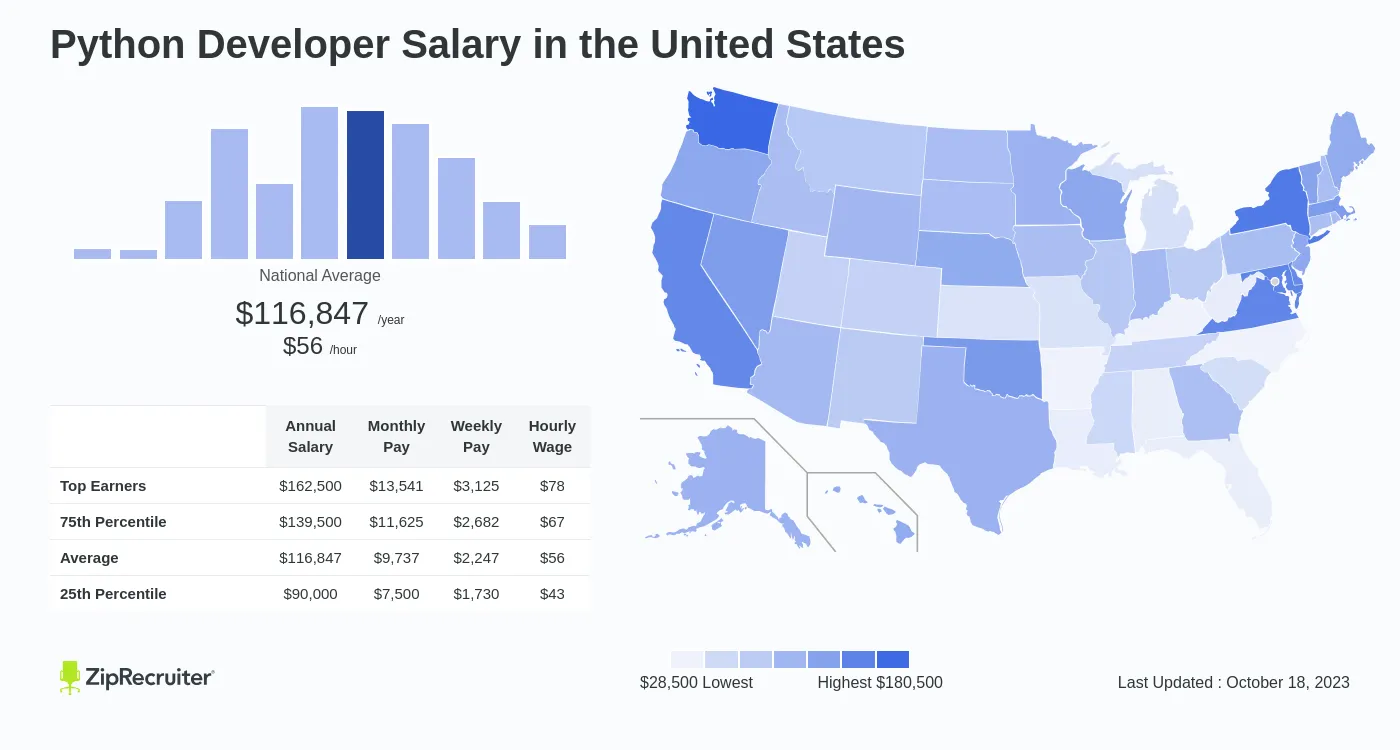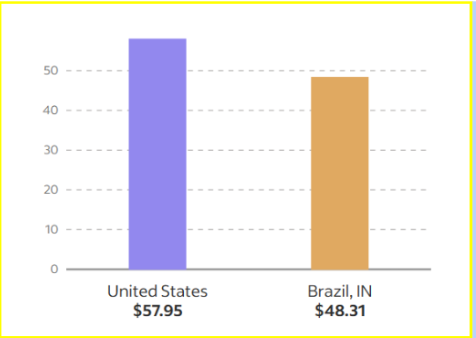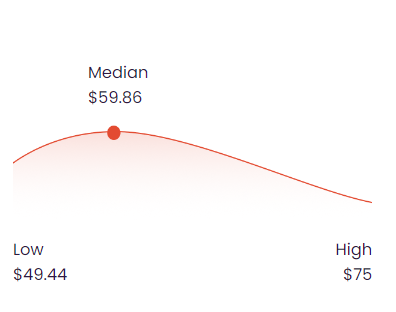A Detailed Look at Python Developer Hourly Rates
The article explores Python developer hourly rates. In the United States, senior Python developers charge about $62 – $63 per hour. Rates vary by hiring type, with freelancers earning $20 – $60 per hour and remote developers earning $45 – $70 per hour. It also compares rates in different countries and industries and highlights high demand for Rust and Python Machine Learning Developers.
Table of Contents
As one of the world’s most popular programming languages, Python offers an unrivaled combination of simplicity, flexibility, and power. Its diverse applications range from web and software development, data analysis, machine learning, artificial intelligence network programming, and more.
Python’s popularity and functionality have continued to expand, companies are urged to hire Python developers. However, when it comes to hiring a Python developer or deciding to hire dedicated developers specializing in Python, one important question often arises: What is the expected hourly rate? In this post, we delve into various factors influencing Python developer hourly rates, providing insights to those looking to hire Python developers in the current market landscape.
Based on data collected by ZipRecruiter, Python developer hourly rates for talent in the United States currently stands at $56 per hour.

An Analysis of Python Developer Hourly Rates by Hiring Type
Freelance hiring offers the most flexibility, with developers able to work remotely and on their own schedule. However, this method may introduce issues of availability and focus if the developer is juggling multiple projects.
Remote hiring provides more project dedication than freelancing. Although it requires a well-managed remote system, it ensures that the developer is more invested in your company’s growth since they are more closely associated with your organization.
On-site hiring, the traditional approach, fosters team unity and promotes in-person collaboration. Despite its geographical limit and lack of flexibility compared to remote options, it can create a solid, unified team dynamic. According to Indeed, the hourly rate of a senior Python developer per hour in the United States in 2023 is $57.95.
| Type of Hiring | Average Hourly Rate |
|---|---|
| Freelance | $20 - $40 |
| Remote | $38 - $50 |
| On-site | $40 - $52 |
Python Developer Hourly Rates by Experience Across Different Platforms
For entry-level developers, there appears to be some degree of variation in the data across platforms, with the ZipRecruiter estimate being notably lower than the others. This could indicate a wider market variance for entry-level rates, potentially due to factors like education, specific skills, or location.
Mid-level developer data shows similar variation, with the PayScale platform’s estimate significantly lower compared to the others. This discrepancy could be attributed to the broad range of skills and experiences that might fall into the “mid-level” category, leading to different interpretations of what constitutes a mid-level developer.
In the senior level, hourly rates across the different platforms are remarkably consistent, showing minimal variation. This consistency could suggest a more defined market value for senior Python developers, possibly due to their extensive experience, specialized skills, or leadership abilities.
| Experience Level | Indeed | Glassdoor | PayScale | ZipRecruiter |
|---|---|---|---|---|
| Entry-level | $36 | $31 | $32 | $23 |
| Mid-level | $52 | $50 | $38 | $53 |
| Senior | $62 | $63 | $62 | $63 |

However, according to Payscale, a Python Developer in the initial stages of their career, boasting 1-4 years of experience, typically garners an average total compensation of $27.50, considering factors such as tips, bonuses, and overtime pay, as indicated by data from 39 salary reports.
Comparing Developer Hourly Rates Across Industries
The Banking and Finance sector has the highest demand, potentially due to the intensive data analysis, algorithmic trading, and cybersecurity measures that Python can help with in this industry.
The Energy and Biotechnology sectors follow closely, indicating the value of Python in dealing with large data sets, simulations, and advanced scientific computations.
Industries such as Insurance and Legal, Travel and Tourism, and Healthcare also show a substantial need for Python developers. This is likely because these industries have recognized the benefits of data analysis, automation, and machine learning capabilities offered by Python.
The demand in Marketing and Advertising, Automotive, Government, and Education sectors is slightly lower, but Python is still valuable in these fields. In Marketing and Advertising, Python can help analyze customer behavior data; in Automotive, Python is useful for automation and testing; in Government, Python can aid in data analysis and automation of tasks; and in Education, Python is commonly used for teaching programming and for research purposes.
| Industry | Average Hourly Rate |
|---|---|
| Banking and Finance | $44 |
| Energy | $41 |
| Biotechnology | $38 |
| Insurance and legal | $37 |
| Travel and tourism | $36 |
| Healthcare | $35 |
| Marketing and advertising | $34 |
| Automotive | $33 |
| Government | $32 |
| Education | $31 |
Python Developer Hourly Rates Around the World
In the United States, there’s a clear lead in terms of rates at all experience levels, reflecting the high demand for programming skills and the cost of living in this country.

According to Indeed, the hourly rate of a senior Python developer in the United States is higher by $9.67 compared to that of a Latam developer in 2023.
Canada, the United Kingdom, Germany, and Australia also have higher rates, indicating strong markets for Python developers. These countries have a significant technological presence and show a consistent increase in rates with developer experience.
Denmark, Ukraine, and Poland offer more economical rates. The lower rates in these countries might reflect lower living costs or a larger pool of developers, and these could be attractive destinations for businesses seeking to manage costs while accessing a skilled talent pool.
In India, the rates are the lowest among the listed countries, but this doesn’t necessarily reflect on the quality of work. The lower rates are often a reflection of the cost of living and the competitive job market in the country.
| Country | Junior Developer | Mid-level Developer | Senior Developer |
|---|---|---|---|
| United States | $46 | $58 | $69 |
| Canada | $24 | $37 | $50 |
| United Kingdom | $26 | $42 | $58 |
| Germany | $26 | $39 | $50 |
| Denmark | $15 | $21 | $30 |
| Ukraine | $12 | $22 | $40 |
| Poland | $13 | $16 | $27 |
| Australia | $27 | $45 | $60 |
| India | $7 | $12 | $18 |
According to the latest updates on Glassdoor, the hourly rate of a midlevel Python developer in the United States is $49. Yet, statistics from talent.com suggest otherwise. According to talent.com, the basic salary of a midlevel Python developer is about $59.86 in the United States.

Python Developer Hourly Rates Against Other Programming Languages
Rust and Python Machine Learning Developers are at the top of the range, indicating the increasing demand for system-level programming and machine-learning capabilities in the industry.
Java/JavaScript, C#, PHP, ASP.NET, and Python SQL developers have a similar demand range, reflecting their wide usage in various applications from web and software development to database management.
Python Web Developers, Ruby, HTML/CSS, and R fall into the lower range, but they are still in demand in their respective domains. HTML/CSS are the building blocks of web development, Ruby is often used in web applications, and R is key in statistics and data analysis.
This comparison underscores the broad range of programming languages and specializations in the tech industry, each with its unique demand, influenced by their specific applications and industry needs.
| Programming Language | Average Hourly Rate |
|---|---|
| Rust | $56 |
| Java/JavaScript | $48 |
| HTML/CSS | $39 |
| Ruby | $42 |
| PHP | $46 |
| C# | $52 |
| R | $37 |
| ASP.NET | $45 |
| Python SQL Developer | $47 |
| Python Web Developer | $40 |
| Python Machine Learning Developer | $56 |
Conclusion
While Python developer rates are influenced by various factors such as location, experience, and specialization, the cost should not be the sole deciding factor when you’re looking to hire Python developers. It’s important to consider other aspects such as the developer’s reputation, past projects, communication skills, and compatibility with your project requirements. Write an accurate Python developer job description and conduct a stringent interview process to land the ideal Python dev for your requirements.
If you’re in the market to hire dedicated developers, consider a holistic approach. Refer to our exclusive Python developer hiring guide for more information. Beyond rates, assess their commitment and passion for delivering quality work. Focusing on these aspects will ensure that your investment yields the most value, not just in terms of project completion, but also in terms of innovation, efficiency, and long-term support.
To hire pre-vetted Python developers from CloudDevs, get in touch with our consultants today.
Table of Contents






